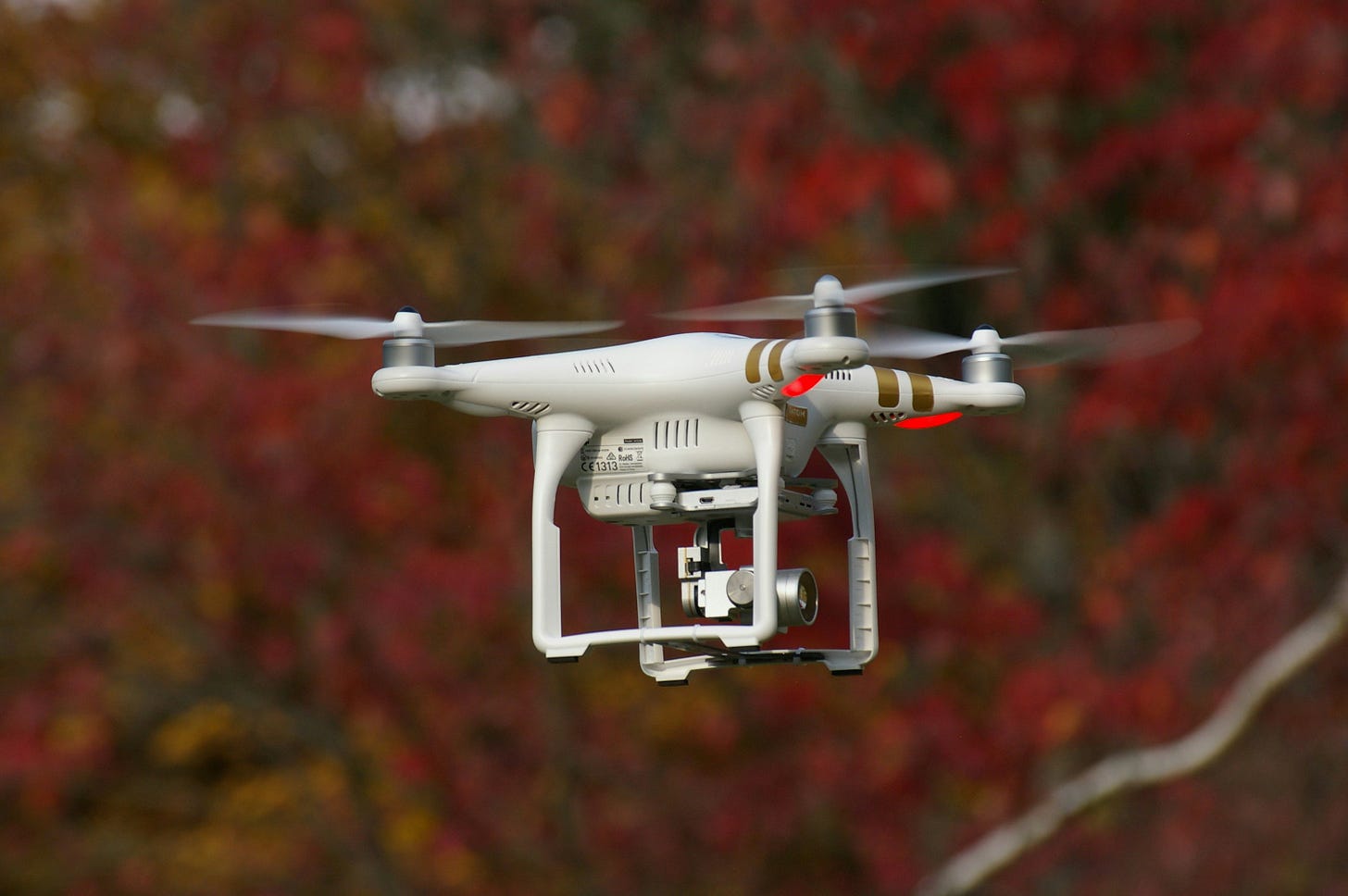Little guys, big impacts
#15: Engineering geniuses, pesky drones, Nordic Nirvana, Angostura bitters, and the caretaker who put a man on the moon...

Tales from the fringes of sport and society…
At the height of the Space Race in 1962, with John F. Kennedy having won the election two years earlier on a promise of beating the Russians to the moon, the President paid a maiden visit to NASA to check in on the progress of the Apollo mission.
While he was mainly there to meet the trainee astronauts and talk to the scientists and engineers behind this era-defining mission, Kennedy’s natural inclination led to occasional interactions with other members of staff.
Midway through his tour of the space centre that would one day bear his name, the President walked by a caretaker sweeping the corridors. “I’m Jack Kennedy,” he said, offering his hand to the man before asking, “What is it you do here at NASA?”.
Without missing a beat, the handyman put down his broom and shook hands with the visitor. “I'm helping put a man on the moon, Mr President,” came the response.
The tale might well be apocryphal, but the narrative helped to shape a clear vision for every worker who walked through the doors at NASA. No matter how small the role, everyone was playing their part towards mankind’s greatest achievement.
October is an important month in the history of the space programme. This month in 1961 saw Apollo’s first unmanned flight, and the same month seven years later witnessed its first crewed mission in Apollo 7.
And so, despite the date, there’s no spooky or kooky in this month’s newsletter. You’ll find no werewolves with this here moon. Instead, our theme is little guys - in this case people, countries, and objects - making big impacts.
With pesky drones in Belgrade, happy citizens in Finland, pioneering Bolivian mountain guides, and engineering geniuses in coal mining and rollercoaster design, I daresay you won’t find a selection like this anywhere else.
Enjoy the read, and happy Halloween!

Far-flung adventures: Keith Armstrong’s 35 years in Finland
Earlier this month, England travelled to Helsinki to play Finland in the UEFA Nations League. The visitors won 3-1 in a relatively routine victory, but don’t expect it to have upset the home fans too much.
That’s because this small nation of just five million people is showing the rest of the world how it’s done in a metric that matters more than any sporting result. For the seventh year in a row, Finland was named the happiest country in the world.
It reminded me of a feature I wrote for The Set Pieces a few years back, when I interviewed football manager Keith Armstrong. Born in Northumberland, Armstrong played for Sunderland in the late 1970s before he made the unusual transfer to Finnish side OPS. When I spoke to him, he was still living in the Land of a Thousand Lakes, having forged a successful coaching career there, too. This meant he was well placed to explain what his adopted country was doing so well at keeping its citizens happy.

The drone that started a riot
The latest episode of the BBC Sporting Witness podcast focuses on an event that occurred a decade ago this month during a politically charged Euros qualifier between Serbia and Albania. Such was the animosity between fans that no Albanian supporters were permitted inside the stadium in Belgrade, but that didn’t stop one of them, Ismail Morinaj, from affecting the match's outcome.
Hiding in a church across the road from the stadium, Morinaj flew a drone into the stadium 42 minutes into the game. Attached to it was a provocative pro-Albanian flag, lighting the touch paper on a sequence of events that would see Serbia eliminated and Albania qualify for their first-ever major tournament.

The canary
Michael Lewis is the don when it comes to transforming the mundane into the magnificent. From baseball analytics (Moneyball) to sub-prime mortgages (The Big Short), no subject matter is too tenuous for Lewis to unearth fascinating characters and gripping storylines. His latest longread for the Washington Post concerns the unassuming civil servant who revolutionised coal mining safety and saved the lives of hundreds of miners. As is often the case with Lewis, don’t let the seemingly dry subject matter put you off, dive in and enjoy a master of his craft.
Their jobs were insanely risky, but they seldom complained and at times even courted risk. They routinely ventured beyond the pillars that prevented the mountain from falling in on them, and into areas where the mountain floated over their heads without support. They upped the odds of a methane explosion by smoking inside the mine. “The way they judged a new boss was to whip out a cigarette and see if he said anything,” said Chris. “If he said something, he was done. He’d never be able to mine any coal.”
A Bolivian cholita climber on sexism and her next summit
Meet Cecilia Llusco, the Indigenous female mountain guide breaking barriers in Bolivia. One of around 10 female guides in the country, Llusco and her peers are changing the face of tourism in the region, traditionally a male-dominated industry.
She continues to fight sexism and discrimination in a country that, as mentioned in this article from Sarah Johnson, has one of the highest rates of femicide in South America. Undeterred, Llusco is determined to teach her daughter to follow in her footsteps. It’s a great read supplemented with stunning imagery from the mountains.
“Since I began climbing mountains, I’ve learned the same applies to life,” she adds. “It’s not about getting to the top, but enjoying yourself on the journey. The most important thing is to be happy.”
The rollercoaster king: the man behind the UK’s fastest thrill-ride
A few weeks ago I went to Flamingo Land with the kids, where my nine-year-old coaxed me onto a ride they call Hero. Its name derives from the fact its victims riders are strapped in horizontally and head first, replicating what it might feel like to fly like Superman. As a recently turned 40-year-old with a neck made of Play-Doh, it’s fair to say I was more than a little nervous about what was to come.
Only to spend the next three minutes swooping and whooping like a rodeo cowboy, giggling like a mischievous toddler, and then emerging from the ride with pupils the size of Pluto. What a rush!
Then, a couple of weeks later, I stumbled on this brilliant article in The Guardian, which profiles some of the rollercoaster architects - legends in the industry but ghosts to the majority of thrill-seekers - behind the biggest and best coasters in the world. Brit John Burton is the main focus but the article also mentions Walter Stengel, the man who came up with so many rollercoaster innovations that one of them - a wild rotational turn that creates sensations of weightlessness - is even named after him. And guess what, it turns out that Stengel designed the Hero ride that made my day.
Rollercoaster creators have known that the appeal of what they offer is the near-dangerous, the danger-adjacent; a succession of danger-flavoured sensations, undertaken in conditions of guaranteed non-danger. The creator makes a promise to the passenger. Whatever happens during this ride will stop happening, leaving you a story to tell.
Everything you ever wanted to know about Angostura bitters
Controversial opinion alert: Mad Men was better than The Sopranos, The Wire, and Breaking Bad. There, I said it. But while Don Draper had many questionable aspects to his character, his love for an Old Fashioned was not one of them. And as anyone partial to what is considered the original cocktail will know, the Old Fashioned is nothing without a dash of the bitters. But what the hell is it? And how can something so small be so powerful? This five-year-old article from Esquire, stumbled upon when enjoying a cheeky little Friday night concoction of my own, explains all.
Inside the nightly cleaning of the 9/11 memorial reflecting pools
Whether it's a desire to ensure those who died are never forgotten or, more cynically, it's just good for clicks, the anniversary of 9/11 often sees media outlets desperate to present a new take on that dreadful day. Whether it's previously unearthed footage or audio, or the latest conspiracy nonsense, it’s unlikely to be helpful for the mourning families forced to relive it every year.
Which is why I thought this short documentary, by Joshua Charow, offered a refreshing take on the anniversary by not dwelling on the horrors and actions of the day itself, but rather focusing on the hard work of those helping to memorialise the human stories of those lost, and maintaining a symbol of New York's recovery. Click to watch it below.
Open: An Autobiography, Andre Agassi
“It's no accident, I think, that tennis uses the language of life. Advantage, service, fault, break, love, the basic elements of tennis are those of everyday existence, because every match is a life in miniature. Even the structure of tennis, the way the pieces fit inside one another like Russian nesting dolls, mimics the structure of our days. Points become games become sets become tournaments, and it's all so tightly connected that any point can become the turning point. It reminds me of the way seconds become minutes become hours, and any hour can be our finest. Or darkest. It's our choice.”
Compared to many of his rivals, Andre Agassi wasn’t the most imposing on the court, especially with a bow-legged walk that made him look smaller than his 5’11 frame. But his stature didn’t prevent him from amassing eight major wins and an Olympic gold medal. By the time he retired in 2006, he’d arguably become the sport’s biggest-ever star.
When his autobiography was released in 2009 it became a worldwide bestseller, in large part due to his brutal honesty and controversial drug revelations, but also thanks to ghostwriter JR Moehringer’s lyrical prose.
The very nature of the role means that ghostwriters are rarely credited when the books they write do well, but given that Open went on to influence future sports memoirs (which can so often be paint-it-by-numbers stale), it’s worth mentioning the American writer who would go on to write Prince Harry’s 2023 autobiography, Spare.
Agassi’s account begins with a wince-inducing description of the pain tennis has inflicted on his body, and why he's desperate to retire from a sport he claims to have hated from the moment he was forced into it by his relentless father.
The real testament to the power of his account isn’t just that he manages to convince the reader that he resents the thing that has made him rich, famous, and loved. It’s how - through vivid and artfully told memories - he manages to explain why, like an addict yearning for escape, he continued to play for so long.
Thanks for reading October’s edition of Off-Field. If you enjoyed the read, you can use the buttons below to like the newsletter, post a comment, or share it with others.
You can get in touch at hello@off-field.net
Read previous editions of Off-Field at offfield.substack.com/archive
Subscribe free for future editions of Off-Field, or share it with a friend:
“If you think you are too small to make a difference, you haven't spent a night with a mosquito” - African proverb











